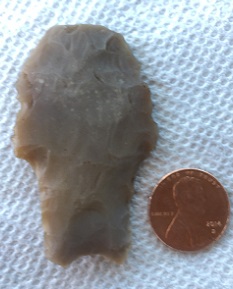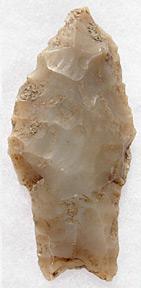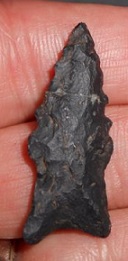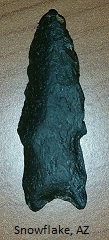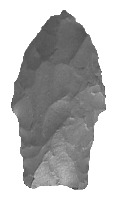Outline is Representative of Size and Shape:

Name Details:
Identified By: Cynthia Irwin-Williams
Named For: Anasazi Origins Project of northwestern New Mexico
Date Identified: 1973
Type Site:
Identified By: Cynthia Irwin-Williams
Named For: Anasazi Origins Project of northwestern New Mexico
Date Identified: 1973
Type Site:
Point Validity:
Valid type
Irwin-Williams was a distinguished Anthropologist who did extensive work in Colorado and the surrounding region. The studied, identified, and named the Picosa Archaic Culture. This point was named in a professional publication and has many professional references. This is considered a valid type.
Irwin-Williams was a distinguished Anthropologist who did extensive work in Colorado and the surrounding region. The studied, identified, and named the Picosa Archaic Culture. This point was named in a professional publication and has many professional references. This is considered a valid type.
Bajada Stemmed
Cluster: Bajada Cluster Description of Physical Characteristics and Flaking Pattern:
This is a medium to large stemmed lanceolate point with an elliptical to diamond shaped cross section. The blade varies from excurvate to almost straight. The shoulder may vary from horizontal to having an upward angle, or may be weak or absent. The stem is long and primarily straight, but may be slightly expanding towards the ears. The base is concaved to bifurcated and commonly thinned with basal and hafting region grinding present. This is manufactured with percussion flaking with finishing pressure flaking forming a random flaking pattern, most examples have fine, high quality flaking. This point is rarely serrated.
Size Measurements:
Total Length - 42 to 77 mm (average 35 to 45 mm), Stem Length - 9 to 23 mm (average 17 to 19 mm typical stem to blade ratio is 1:1.9), Blade Width - 16 to 28 mm (average 18 to 20 mm), Stem Width at shoulders 11 to 20 mm, Basal Width - 11 to 19 mm, Thickness - 5 to 10 mm.
Total Length - 42 to 77 mm (average 35 to 45 mm), Stem Length - 9 to 23 mm (average 17 to 19 mm typical stem to blade ratio is 1:1.9), Blade Width - 16 to 28 mm (average 18 to 20 mm), Stem Width at shoulders 11 to 20 mm, Basal Width - 11 to 19 mm, Thickness - 5 to 10 mm.
Additional Comments:
This point is similar to the Jay point, but on this point the basal concavity with basal thinning and is a smaller and more prevalent point. Similar Pinto and San Jose points have a shorter stem than is seen on the Bajada point.
Some examples have a single shoulder and were thought to be a variant of the Sandia point (Justice, 2002).
This type incorporates two previously defined types, The Rio Grande and the Escobas type. The Rio Grande point originally had a wide definition and have now been broke down into the Bajada, San Jose, Jay, and Escobas points (Justice, 2002)
Escobas point may be distinguished from the Bajada point by it's slight incurvate of the lateral edge of the stem (Justice, 2002).
This point is similar to the Jay point, but on this point the basal concavity with basal thinning and is a smaller and more prevalent point. Similar Pinto and San Jose points have a shorter stem than is seen on the Bajada point.
Some examples have a single shoulder and were thought to be a variant of the Sandia point (Justice, 2002).
This type incorporates two previously defined types, The Rio Grande and the Escobas type. The Rio Grande point originally had a wide definition and have now been broke down into the Bajada, San Jose, Jay, and Escobas points (Justice, 2002)
Escobas point may be distinguished from the Bajada point by it's slight incurvate of the lateral edge of the stem (Justice, 2002).
Distribution: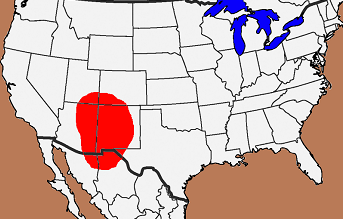

Distribution Comments:
This point is primarily found throughout the Colorado River Valley, San Juan River valley and up into the Moab area. This point may be found with decreased frequency across the Colorado Plateau, the Uncompahgre Plateau, and into the Great Basin.
This point is primarily found throughout the Colorado River Valley, San Juan River valley and up into the Moab area. This point may be found with decreased frequency across the Colorado Plateau, the Uncompahgre Plateau, and into the Great Basin.
Age / Periods:
Date: 6,800 - 5,300 B.P.
Cultural Period: Middle Archaic
Glacial Period: Middle Holocene
Culture: Oshara Tradition
Date: 6,800 - 5,300 B.P.
Cultural Period: Middle Archaic
Glacial Period: Middle Holocene
Culture: Oshara Tradition
Age Details:
This type is associated with the Bajada Phase.
This type is associated with the Bajada Phase.

